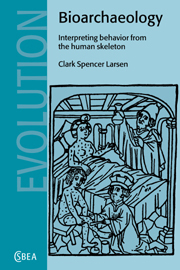Book contents
- Frontmatter
- Contents
- Acknowledgments
- 1 Introduction
- 2 Stress and deprivation during the years of growth and development and adulthood
- 3 Exposure to infectious pathogens
- 4 Injury and violent death
- 5 Activity patterns: 1. Articular and muscular modifications
- 6 Activity patterns: 2. Structural adaptation
- 7 Masticatory and nonmasticatory functions: craniofacial adaptation
- 8 Isotopic and elemental signatures of diet and nutrition
- 9 Historical dimensions of skeletal variation: tracing genetic relationships
- 10 Changes and challenges in bioarchaeology
- References
- General index
- Site index
1 - Introduction
Published online by Cambridge University Press: 05 June 2012
- Frontmatter
- Contents
- Acknowledgments
- 1 Introduction
- 2 Stress and deprivation during the years of growth and development and adulthood
- 3 Exposure to infectious pathogens
- 4 Injury and violent death
- 5 Activity patterns: 1. Articular and muscular modifications
- 6 Activity patterns: 2. Structural adaptation
- 7 Masticatory and nonmasticatory functions: craniofacial adaptation
- 8 Isotopic and elemental signatures of diet and nutrition
- 9 Historical dimensions of skeletal variation: tracing genetic relationships
- 10 Changes and challenges in bioarchaeology
- References
- General index
- Site index
Summary
Many thousands of archaeological human skeletons are currently housed in various institutional repositories throughout the world. Some of these collections are extensive: at last count, the Smithsonian Institution alone has some 32000 catalogued records of human remains (Loring & Prokopec, 1994). This surfeit of skeletons suggests that teeth and bones are recognized by anthropologists as a valuable source of information for interpreting lifeways of past peoples. There is considerable evidence to indicate the contrary, however. An extensive review of archaeological human skeletal samples from the southern United States – including parts or all of the states of Arkansas, Louisiana, Texas, Oklahoma, Kansas, Colorado, and New Mexico – reported that aside from simple descriptive information (bones present, age-at-death, sex) only a very small percentage of human remains has been studied by biological anthropologists (Steele & Olive, 1989). For the entire southern half of Texas, an area encompassing thousands of square miles, over 300 mortuary sites have been reported by archaeologists, but skeletons from only 50 of these sites are described (Steele & Olive, 1989). Human remains from only eight sites were described and interpreted in detail. In the same review, Owsley and coworkers observed: ‘many American archeologists have not appreciated the full potential of osteological research as a source of information on biocultural behavior and human adaptation. Many of these views persist, as reflected in an archeologist's statement to a reporter visiting a field school excavation in Colorado: “Human bones don't provide that much information. After all, we know that they are Indians.”’ (1989:122).
- Type
- Chapter
- Information
- BioarchaeologyInterpreting Behavior from the Human Skeleton, pp. 1 - 5Publisher: Cambridge University PressPrint publication year: 1997
- 2
- Cited by



